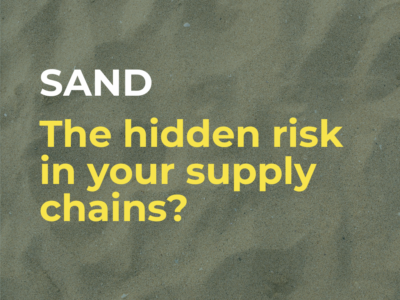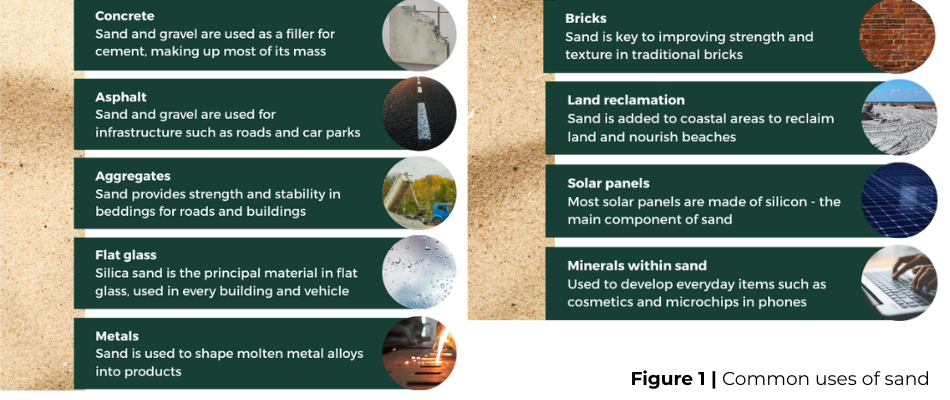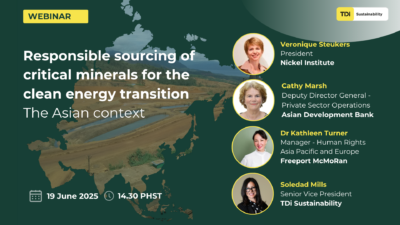
Sand | The Hidden Risk in Your Supply Chains?
Sand and other silicate materials are the world’s most mined solid raw materials, with more than 50 billion tonnes of sand being extracted from marine, riverine and terrestrial ecosystems every year.2
Sand and gravel are the main components of human-made mass, which is now calculated by the World Economic Forum to exceed all living biomass on Earth.1 With sand being essential for everything from construction and transport infrastructure to industrial manufacturing and energy production (figure 1) sand has been described as the cornerstone of global development. In terms of the clean energy transition, high-quality sand is the essential starting point for the production of solar panels, and is also the primary raw material used to make semiconductors required for photovoltaic technology.

Sand is therefore critical for global economies, but its importance and the ESG risks associated with its extraction are typically less widely spoken about than other critical materials. In addition, the perception that sand is ‘everywhere’ hides the fact that its current rate of extraction vastly exceeds its natural replenishment.
The ESG cost of sand
Sand excavation often takes place in an unregulated manner from fragile ecosystems, putting the natural environment, communities and associated local infrastructure at risk.
Our ever-growing demand for urbanisation and manufacturing has now led to what many are calling a sand crisis.3 According to the United Nations Environment Programme and GRID-Geneva, sand resource governance is one of the greatest sustainability challenges of the 21st Century.4
The ESG issues associated with the extraction of sand include:
- Habitat destruction, biodiversity loss and erosion
- Water scarcity and loss of water security – for example where sand mining for metals drains local water sources
- Salinisation of aquifers and groundwater reserves
- Saltwater intrusion and shoreline erosion leading to the collapse of infrastructure and loss of farmland
- The loss of traditional livelihoods such as farming and fishing – negative impact on local economies dependent on riverine and coastal ecosystems
- Health and safety hazards in regions where mining is informal, due to regulatory gaps
- Coercion, violence and corruption in regions where oversight is minimal or absent – intimidation and violence as a result of ‘sand mafias’
- Exacerbation of wealth disparities
- Undermining of local governance where the needs of the mining industry are prioritised over those of local communities
- Reduced resilience of rivers to extreme weather events due to dredging
Circularity as a partial solution
The historic and current approach to sand value chains is linear – prioritising extraction over environmental, social and long-term sustainability. Inefficiencies along the value chain including wastage at construction sites compound this problem. 5
Circular economy principles are emerging as a promising mitigation strategy to reduce waste and keep materials in use. The use of end-of life aggregates for re-use and recycling is projected to increase five-fold by 2060, however, this continues to fall significantly short of demand.6 In addition, circularity alone cannot address the rising demand for sand and its socio-ecological impacts.
Impact on downstream companies
Based on the environmental and social impacts associated with the extraction of sand that are highlighted in this article, it is important that companies don’t underestimate their potential supply chain risk exposure from sand, and the they recognise their potential role in the future stewardship of this fragile resource.
To date, sand extraction has been minimally regulated. However, approaches to due diligence for the sourcing of sand and silicates are emerging, based on OECD guidance. As part of their responsible sourcing strategy, companies should therefore identify if and where sand is present in their supply chain and production processes. To meet stakeholder and reputational requirements for a robust approach to supply chain risk, due diligence should then be carried out to ensure that the environmental, social and governance risks associated with the production and supply of that sand have been identified. TDi Sustainability can help map critical materials, such as sand, in your supply chain, using a combination of digital tools and our consultants’ expertise to identify the inherent and residual risks present, and provide advice and practical support to mitigate those risks.
To ensure future supply chain resilience, companies should also ensure that they are monitoring their requirements for sand and identifying potential efficiency improvements that could be made in production processes, as well as opportunities for end-of-life recycling.
In order to develop systemic change – companies using sand should endeavour to become engaged in wider conversations on the responsible sourcing of sand. By understanding the potential impacts, engaging with stakeholders, developing an awareness of supply chains and adopting sustainable practices, they can contribute to minimising the negative consequences of sand extraction and help to protect both the environment and communities that rely on sand resources.
Downstream companies can also proactively engage in research and collaboration to support transparency and risk mitigation, for example by contributing to initiatives such as the Global Centre for Minerals Security’s (GCMS) Responsible Sand and Silicates Initiative, which is working to establish a formal multi-stakeholder coalition dedicated to responsible sand and silicate resourcing.
Get in touch to find out more about how TDi can help you to:
- Map and monitor the use of sand in your supply chains
- Identify the ESG risks associated with sand in your supply chain
- Mitigate the risks and get involved with initiatives and projects aimed at reducing the environmental and social risks associated with the extraction of sand
References
1 https://www.weforum.org/stories/2021/12/weight-accumulation-human-made-mass-earth/#:~:text=Bricks%20and%20aggregates%20like%20gravel,terrestrial%20and%20marine%20animals%20combined. (Accessed 16 April 2025)
2A. Torres, M.U. Simoni, J.K. Keiding, D.B. Müller, S.O. Zu,Ermgassen, J. Liu, J.A. Jaeger, M. Winter, E.F. Lambin. Sustainability of the global sand system in the Anthropocene – One Earth, 4 (2021), pp. 639-650
3 K. Pereira – Sand Stories: Surprising Truths about the Global Sand Crisis and the Quest for Sustainable Solutions
Rhetority Media, London, UK (2020), p. 333
4 https://unepgrid.ch/en/sand (Accessed 16 April 2025)
5 https://www.sciencedirect.com/science/article/pii/S2590332225000338#bib5 (Accessed 16 April 2025)
6 https://www.sciencedirect.com/science/article/abs/pii/S2590332225000259 (Accessed 16 April 2025)
 supply chain
supply chain
Responsible sourcing of critical minerals for the clean energy transition | The Asian context
6th June 2025 Industry Initiatives
Industry Initiatives
Working with the Natural Polymers Group (NPG)
5th June 2025 Mining
Mining
